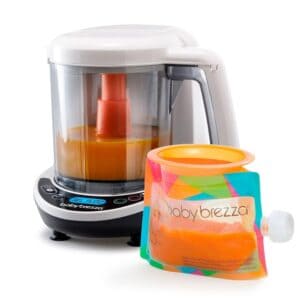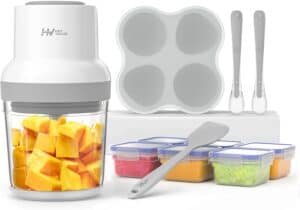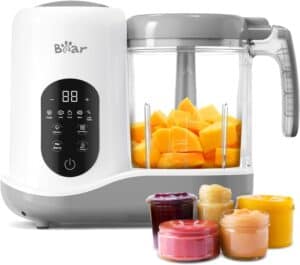How to puree food for elderly loved ones is a common questions caretakers face. As people age, eating becomes more challenging due to issues like dental problems, difficulty swallowing, or medical conditions such as Alzheimer’s disease or Parkinson’s disease. For many elderly individuals, a pureed diet becomes essential to ensure they can safely consume meals while still meeting their nutritional needs. Pureeing food offers a way to provide familiar, delicious meals in a smooth consistency that’s easy to swallow without sacrificing essential nutrients. In this guide, we’ll walk through the process of pureeing food, share tips for creating a variety of nutritious meals, and provide several delicious pureed recipes that will help maintain a healthy and balanced diet for your loved ones.
*This post includes affiliate links, which means if you make a purchase through one of these links, I earn a small commission at no extra cost to you. This helps me keep providing high-quality content on this site for free. Rest assured, I only recommend products that I would personally use and believe will be helpful for my readers.
How to Puree Food for the Elderly: Nutritious Recipes and Tips
Maintaining proper nutrition becomes more challenging, especially for those with difficulty swallowing, dental issues, or medical conditions like Parkinson’s disease or Alzheimer’s disease. A pureed diet can help elderly individuals meet their nutritional needs while ensuring they can eat safely and comfortably. This article will guide you through the process of creating nutritious and delicious pureed meals, offer expert tips, and provide several recipes to ensure elderly loved ones enjoy their food without compromising their health.
I love this resource: The Geriatric Dietition
Why a Pureed Diet is Essential for Elderly People
A pureed diet is often recommended for elderly individuals who have trouble chewing or swallowing due to medical conditions such as gum disease, tooth loss, Parkinson’s disease, Alzheimer’s disease, or other neurological disorders. Such cases require soft, easy-to-swallow foods that still provide the essential nutrients for healthy living. A pureed meal ensures that elderly individuals can enjoy a balanced diet without the risk of choking or unintentional weight loss.
For many older adults, issues like dental problems or cognitive changes make it difficult to consume solid foods, leaving many caretakers asking, how to puree food for the elderly. Eating can become painful, or they may struggle with the mechanics of chewing and swallowing. Pureeing food provides a solution by offering meals that are easy to consume but still packed with flavor and nutrition.
A study on nutrition in older adults shows that nearly 40% of elderly individuals experience some form of malnutrition, often exacerbated by difficulty swallowing or consuming regular foods. In such cases, a well-planned pureed food diet can prevent malnutrition while ensuring adequate intake of vitamins, minerals, and other important nutrients.
How to Properly Puree Foods for Elderly Individuals
Pureed foods can be simple to make, but it’s important to follow the right process to achieve the proper smooth consistency and preserve the food’s nutritional value. Here’s a step-by-step guide to help you puree foods for elderly individuals:
Tools and Equipment:
- Stick blender or hand blender: These tools are ideal for blending food directly in a bowl or pot, creating a smooth texture quickly and efficiently.
- Food processor: For larger batches of pureed meals, a good-quality food processor can save time and effort.
- Thickening agent: Sometimes, a thickener like potato flakes or commercial thickening agents may be necessary to achieve the right consistency.
Step-by-Step Process:
- Choose the Right Foods: Start with ingredients that puree well, such as sweet potatoes, chicken broth, cottage cheese, or cream of wheat. Be mindful of health problems and dietary needs.
- Add Liquid for Smoothness: Ensure your food reaches a smooth consistency by adding appropriate liquids. Some options include:
- Olive oil or chicken broth for savory meals.
- Coconut milk or apple juice for sweeter dishes like fruit purees. Adjust the amount of liquid based on the food’s density.
- Achieving the Right Texture: The goal is a pudding-like consistency, so the food is easy to swallow but not too thin. For some foods, a thickening agent like potato flakes may be required to achieve the desired texture.
Tips for Flavor and Texture
One common issue on how to puree food for elderly is getting the texture and flavor just right so that the meal can be enjoyable.
- Use spices and herbs to enhance flavor without adding too much salt.
- Add ingredients like protein powder or Greek yogurt to boost the nutrient content of your pureed meals.
- Use a combination of healthy fats (e.g., olive oil) to ensure the food is flavorful and nutrient-dense.
Eatright.org provided a great article on nutrients by age!
3 Food Processors: How to Puree Food For Elderly Loved One
In order to accomplish the proper consistency, you need the best tools. Check out these processors to understand how to puree food for elderly loved one so that they can enjoy their meal.
- Baby Brezza – this is the high value option
2. Hey Value Processor with Silicone Containers
3. Bear Processor Steamer, Blender, Cooking Grinding.
How to Puree Food for Elderly: Nutritious Pureed Recipes
Providing variety in pureed meals is essential to maintaining a healthy diet and ensuring your loved one enjoys their food. Here are some easy and nutritious recipes:
Breakfast Options:
- Cream of Wheat with Brown Sugar and Banana:
- Ingredients: 1 cup cream of wheat, 1 ripe banana, 1 tablespoon brown sugar, and a splash of milk.
- Directions: Cook the cream of wheat as directed, puree with the banana and brown sugar, and add milk to achieve the right texture. This warm and comforting dish is perfect for an energy-boosting breakfast.
- Mango Banana Smoothie:
- Ingredients: 1 ripe mango, 1 ripe banana, ½ cup Greek yogurt, ½ cup coconut milk, and 1 tablespoon honey.
- Directions: Blend all the ingredients until smooth. This smoothie provides a burst of vitamins and is easy to consume.
Lunch:
- Pureed Chicken Soup:
- Ingredients: 1 cup chicken broth, 1 boiled potato, ½ cup cooked carrots, and shredded chicken breast.
- Directions: Puree the ingredients together with a bit of olive oil for smoothness. This dish is hearty and protein-rich.
- Sweet Potato and Carrot Puree:
- Ingredients: 1 sweet potato, 2 carrots, and a splash of chicken broth.
- Directions: Boil the vegetables, then puree them with broth until smooth. This dish is full of fiber and vitamins.
Dinner:
- Beef Stew Puree:
- Ingredients: 1 cup stewed beef, 1 potato, 1 carrot, and beef broth.
- Directions: Puree the cooked ingredients and add beef broth for smoothness. This protein-rich meal is satisfying and flavorful.
- Pureed Fish with Olive Oil and Vegetables:
- Ingredients: 1 piece of white fish (e.g., cod), ½ cup steamed vegetables, and a drizzle of olive oil.
- Directions: Puree the fish and vegetables, adding olive oil to ensure a smooth texture. This meal is light but packed with omega-3 fatty acids.
Desserts/Snacks:
- Cottage Cheese with Honey and Pureed Fruit:
- Ingredients: ½ cup cottage cheese, 2 tablespoons honey, and ½ cup pureed fruit (such as berries).
- Directions: Mix the ingredients together for a protein-rich, healthy snack.
- Apple Sauce with Cinnamon:
- Ingredients: 2 peeled apples, 1 tablespoon brown sugar, and 1 teaspoon cinnamon.
- Directions: Puree the cooked apples with cinnamon and sugar for a classic snack.
Challenges and Solutions in Pureeing Food for Elderly
Common Issues when understanding how to puree food for elderly
- Maintaining Nutritional Value: Pureeing food can sometimes lead to nutrient loss if the wrong ingredients are used or if too much liquid is added.
- Achieving the Right Texture: One common mistake is making the food too thin or too thick, which can affect how easy it is to swallow.
Solutions to How to Puree Food for Elderly:
- Balance the Liquid: Add small amounts of liquid at a time and blend well to reach a smooth consistency without over-thinning the food.
- Use High-Quality Ingredients: Choose nutrient-dense options like sweet potatoes, Greek yogurt, or protein powder to ensure the food remains healthy.
- Flavor Variety: Don’t shy away from adding spices, a bit of lime juice, or herbs to make the pureed meals enjoyable and flavorful.
Tips to Enhance Pureed Meals and Maintain Proper Nutrition
To ensure that pureed meals are not only easy to consume but also meet the nutritional needs of elderly individuals, follow these tips:
- Include All Food Groups: Each meal should incorporate protein, carbohydrates, healthy fats, and fiber. For example, add Greek yogurt or protein-rich foods to boost nutrition.
- Monitor Portion Sizes: As many elderly individuals eat less than younger adults, it’s important to pack essential nutrients into smaller portions.
- Fresh Ingredients: Whenever possible, use fresh ingredients to retain flavor and nutritional value.
- Use Food Molds: For visual appeal, food molds can help make pureed meals more appetizing.
- Encourage Regular Supervision: When feeding an elderly individual with swallowing difficulties, be sure to supervise to avoid choking.
Case Study: Implementing a Pureed Diet in Assisted Living
At Green Pines Assisted Living, many residents faced difficulties with swallowing due to conditions like Alzheimer’s disease and Parkinson’s disease. To improve their overall health and prevent unintentional weight loss, the facility implemented a comprehensive pureed meal plan. Meals included a variety of pureed food recipes rich in protein, vitamins, and healthy fats.
After six months, there was a noticeable improvement in residents’ health, with fewer complaints of malnutrition and better compliance with dietary requirements. This case illustrates the benefits of a pureed diet in ensuring elderly individuals meet their dietary needs. This family identified a way for how to puree food for elderly loved one.
Maintaining a nutritious diet is essential for the health and well-being of elderly individuals, especially those who struggle with swallowing or dental issues. A well-balanced pureed diet can meet their nutritional needs, prevent unintentional weight loss, and improve their overall health.
Experimenting with different pureed foods, from savory meals like beef stew puree to sweeter options like apple sauce, ensures that elderly individuals can enjoy variety and flavor in their diet. Through careful preparation and attention to detail, caregivers can create meals that are not only nutritious but also easy to consume. You now have the tools to understand how to puree food for elderly.














